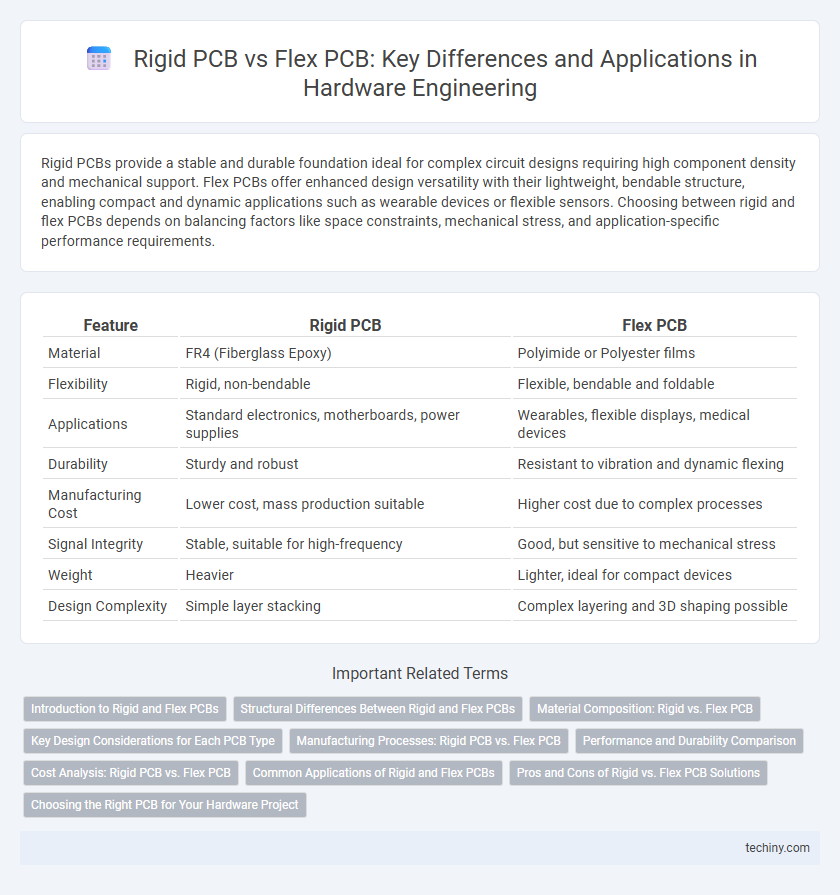Rigid PCBs provide a stable and durable foundation ideal for complex circuit designs requiring high component density and mechanical support. Flex PCBs offer enhanced design versatility with their lightweight, bendable structure, enabling compact and dynamic applications such as wearable devices or flexible sensors. Choosing between rigid and flex PCBs depends on balancing factors like space constraints, mechanical stress, and application-specific performance requirements.
Table of Comparison
| Feature | Rigid PCB | Flex PCB |
|---|---|---|
| Material | FR4 (Fiberglass Epoxy) | Polyimide or Polyester films |
| Flexibility | Rigid, non-bendable | Flexible, bendable and foldable |
| Applications | Standard electronics, motherboards, power supplies | Wearables, flexible displays, medical devices |
| Durability | Sturdy and robust | Resistant to vibration and dynamic flexing |
| Manufacturing Cost | Lower cost, mass production suitable | Higher cost due to complex processes |
| Signal Integrity | Stable, suitable for high-frequency | Good, but sensitive to mechanical stress |
| Weight | Heavier | Lighter, ideal for compact devices |
| Design Complexity | Simple layer stacking | Complex layering and 3D shaping possible |
Introduction to Rigid and Flex PCBs
Rigid PCBs consist of a solid, non-bendable substrate like fiberglass, providing mechanical stability and high durability for fixed electronic assemblies. Flex PCBs utilize flexible polyimide or polyester films, allowing bending and folding to fit complex or compact device configurations. Both types serve distinct applications, with rigid PCBs favoring structural integrity and flex PCBs enabling space-saving and dynamic designs.
Structural Differences Between Rigid and Flex PCBs
Rigid PCBs consist of a solid substrate, typically made of fiberglass epoxy, providing a stable and durable structure ideal for fixed electronic components. Flex PCBs utilize flexible polyimide or polyester films, allowing them to bend and conform to dynamic or compact spaces without damaging the circuitry. The fundamental structural difference lies in the material composition and mechanical properties, with rigid PCBs emphasizing stiffness and flex PCBs prioritizing adaptability and space efficiency.
Material Composition: Rigid vs. Flex PCB
Rigid PCBs are made from solid, inflexible substrates like fiberglass epoxy resin (FR4), providing high mechanical strength and stability for fixed circuit boards. Flex PCBs utilize flexible materials such as polyimide or polyester films, allowing bending and folding without breaking the conductive pathways. The difference in material composition directly influences the PCB's durability, application flexibility, and suitability for compact, complex electronic assemblies.
Key Design Considerations for Each PCB Type
Rigid PCBs require careful consideration of component placement and thermal management to ensure structural integrity and reliable performance under mechanical stress. Flex PCBs demand attention to bend radius, material flexibility, and trace routing to prevent signal degradation and mechanical failure during repeated flexing. Both designs must optimize layer stack-up and electrical properties to meet application-specific requirements, balancing durability with electrical performance.
Manufacturing Processes: Rigid PCB vs. Flex PCB
Rigid PCB manufacturing involves layering and etching processes on solid fiberglass substrates like FR-4, offering stability and durability for traditional circuit designs. Flex PCB production requires specialized flexible materials such as polyimide, combined with precise lamination and bending techniques to maintain circuit integrity under dynamic movement. Both processes demand strict cleanroom conditions, but flex PCB fabrication typically involves additional steps to ensure flexibility and resistance to repeated mechanical stress.
Performance and Durability Comparison
Rigid PCBs exhibit superior mechanical stability and thermal resistance, making them ideal for applications with high heat dissipation and structural demands. Flex PCBs offer enhanced flexibility and shock absorption, enabling better performance in dynamic or vibration-prone environments but typically have lower mechanical strength. While rigid PCBs maintain consistent electrical performance under stress, flex PCBs provide durability through bendability, reducing failure rates in compact or moving assemblies.
Cost Analysis: Rigid PCB vs. Flex PCB
Rigid PCBs generally have lower manufacturing costs due to established mass production processes and simpler assembly requirements, making them cost-effective for high-volume applications. Flex PCBs incur higher initial expenses because of specialized materials and complex fabrication techniques, but they reduce overall system costs by enabling compact designs and fewer interconnects. Cost efficiency between rigid and flex PCBs depends on application complexity, production volume, and long-term reliability considerations.
Common Applications of Rigid and Flex PCBs
Rigid PCBs are commonly used in consumer electronics, automotive systems, and industrial machinery due to their durability and stable mechanical support. Flex PCBs are favored in wearable devices, medical equipment, and aerospace applications where space constraints and dynamic bending are critical. Both types enhance electronic performance by catering to specific design and functionality requirements in various industries.
Pros and Cons of Rigid vs. Flex PCB Solutions
Rigid PCBs offer superior mechanical strength and stability, making them ideal for high-density circuit designs and applications requiring durability under stress. Flex PCBs provide exceptional flexibility and reduce wiring complexity, enabling compact, lightweight device configurations and dynamic motion adaptability. However, rigid PCBs can be bulky and less adaptable to tight spaces, while flex PCBs often come at higher manufacturing costs and may suffer from reduced mechanical robustness over extended use.
Choosing the Right PCB for Your Hardware Project
Selecting the appropriate PCB type depends on the specific requirements of your hardware project, such as space constraints, mechanical stress, and flexibility needs. Rigid PCBs offer stability and durability for fixed, high-performance circuits, while Flex PCBs provide flexibility and lightweight design ideal for compact or dynamic environments. Evaluating factors like bend radius, thermal management, and cost efficiency ensures optimal functionality and longevity in your hardware design.
Rigid PCB vs Flex PCB Infographic

 techiny.com
techiny.com